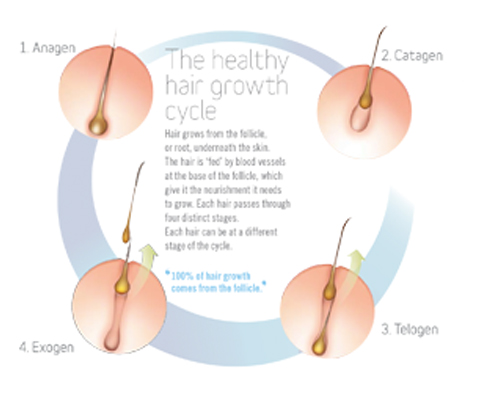
Hair is a protein filament that grows from follicles found in the dermis. Hair is one of the defining characteristics of your face. Hair grows at different speeds and different lengths. Its composition causes different colors and textures, which influence how long the hair strands, grow. It is also normal to lose about 50-100 hairs every day. If you see bald patches or lots of thinning, you may be experiencing hair loss.
There are many causes of hair loss. Women may notice hair loss after giving birth. People under a lot of stress can see noticeable hair loss. Some diseases and medical treatments can cause hair loss. The most common cause of hair loss is a medical condition called hereditary hair loss.
- Male-pattern baldness.
- Female-pattern baldness.
- Androgenetic alopecia.
Luckily, most causes of hair loss can be stopped or treated. Anyone troubled by hair loss should see a doctor. These doctors specialize in treating our skin, hair, and nails.
Hair Growth Cycle
Hair grows from the follicle, or root, underneath the skin. The hair is ‘fed’ by blood vessels at the base of the follicle, which give it the nourishment it needs to grow. Between starting to grow and falling out years later, each hair passes through four stages: anagen, catagen, telogen and exogen. Every hair can be at a different stage of the growth cycle at any given time.
Over time, the length of the anagen stage decreases. Therefore, the hair may become weaker and thinner after each cycle. That’s why it’s important to ensure your diet is rich in specific nutrients to maintain healthy hair growth.
Anagen (Growing Phase): The growing phase lasts 2-7 years and determines the length of our hair.
Catagen (Transition Phase): This is the transitional stage that lasts about 10 days. The hair follicle shrinks and detaches from the dermal papilla.
Telogen (Resting Phase): This is the resting phase which lasts around three months. Around 10-15 percent of hairs are in this phase. Whilst the old hair is resting, a new hair begins the growth phase.

Exogen (New Hair Phase): This is part of the resting phase where the old hair sheds and a new hair continues to grow. Approximately 50 to 150 hairs can fall out daily, this is considered to be normal hair shedding.
If hairs enter the resting phase too early, excess shedding and noticeable thinning can occur.
Male pattern baldness, also called androgenic alopecia, is the most common type of hair loss in men. According to the U.S. National Library of Medicine (NLM), more than 50 percent of all men over the age of 50 will be affected by male pattern baldness to some extent.
What causes male pattern baldness?
One cause of male pattern baldness is genetics, or having a family history of baldness. Research has found that male pattern baldness is associated with male sex hormones called androgens. The androgens have many functions, including regulating hair growth.
Each hair on your head has a growth cycle as mentioned above. With male pattern baldness, this growth cycle begins to weaken and the hair follicle shrinks, producing shorter and finer strands of hair. Eventually, the growth cycle for each hair ends and no new hair grows in its place.
Who’s at risk?
Male pattern baldness can begin in your teenage years, but it more commonly occurs in adult men, with the likelihood increasing with age. Genetics plays a big role. Men who have close relatives with male pattern baldness are at a higher risk. This is particularly true when their relatives are on the maternal side of the family.
Am I losing my hair?
If your hair loss begins at the temples or the crown of the head, you may have male pattern baldness. Some men will get a single bald spot. Others experience their hairlines receding to form an “M” shape. In some men, the hairline will continue to recede until all or most of the hair is gone.
What is female pattern baldness?
Female pattern baldness, also called androgenetic alopecia, is hair loss that affects women. It’s similar to male pattern baldness, except that women can lose their hair in a different pattern than men.
Hair loss in women is normal, especially as you age. Up to two-thirds of women experience hair loss after menopause. It’s more common after menopause, so hormones are likely responsible. If you notice that you’re losing hair, see your doctor. They will be able to determine if you’re experiencing female pattern baldness or another type of hair loss.
The sooner you get treated, the faster you’ll be able to stop the loss — and possibly even regrow hair.
What does female pattern baldness look like?
In female pattern baldness, the hair’s growing phase slows down. It also takes longer for new hair to begin growing. Hair follicles shrink, leading the hair that does grow to be thinner and finer. This can result in hair that easily breaks.
It’s normal for women to lose 50 to 100 hairs each day, but those with female pattern baldness can lose many more.
In men, hair loss starts in the front of the head and recedes to the back until they go bald. Women lose hair from all over their head, starting at their part line. Hair at the temples may also recede.
Women are less likely to go completely bald, but can have a lot of thinning throughout your hair.
Doctors divide female pattern baldness into three types:
- Type I is a small amount of thinning that starts around your part.
- Type II involves widening of the part, and increased thinning around it.
- Type III is thinning throughout, with a see-through area at the top of your scalp.
Can genetics cause female pattern baldness?
Hair loss is passed down from parents to their children, and many different genes are involved. You can inherit these genes from either parent. You’re more likely to have female pattern baldness if your mother, father, or other close relatives have experienced hair loss.
What else causes female pattern baldness?
Female pattern baldness is generally caused by an underlying endocrine condition or a hormone secreting tumor.
If you have other symptoms, such as an irregular period, severe acne, or an increase unwanted hair, consult your doctor. You may be experiencing a different type of hair loss
Can women get female pattern baldness in their 20s?
Women are less likely to develop female pattern baldness before midlife. Like men, women are more likely to start losing hair once they get into their 40s, 50s, and beyond.
High levels of male sex hormones, called androgens, contribute to hair loss in men. It’s generally felt that androgens are also at play in female pattern hair loss.
How is it diagnosed?
If you’ve noticed thinning hair on your scalp, see your doctor .Your doctor will examine your scalp to see the pattern of hair loss. Testing generally isn’t needed to diagnose female pattern baldness.
If they suspect another type of hair loss, they may also perform a blood test to check your levels of thyroid hormone, androgens, iron, or other substances that can affect hair growth.
If low iron is contributing to your hair loss, your doctor might prescribe an iron supplement. At this time, there isn’t any evidence that taking iron will regrow your hair. Other supplements, such as biotin and folic acid, are also promoted to thicken hair.
Treatments:
Is it reversible?
Female pattern baldness isn’t reversible. Proper treatment can stop the hair loss and potentially help regrow some of the hair you’ve already lost. Treatments can take up to 12 months to start working. You’ll need to stay on them long-term to keep from losing your hair again.


